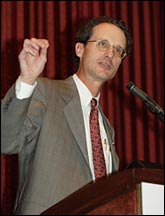Who should decide what level of air pollution is safe — scientists or political appointees?

Plume and doom.
Photo: iStockphoto.
A counterintuitive answer came from top officials at the U.S. EPA last week. Bill Wehrum and George Gray, EPA’s highest-ranking air and science officials, respectively, issued recommendations that some enviros and agency staffers fear could curtail the involvement of scientists and boost the role of political figures in the process of setting national ambient air quality standards (NAAQS) for six major pollutants.
These standards must be updated every five years under the Clean Air Act, and for nearly three decades the process has been driven largely by EPA scientists and a Clean Air Scientific Advisory Committee made up of experts from outside the agency. The process has been pretty straightforward: Staff scientists review the latest studies and data on public and environmental health and identify the concentration of pollution they believe should be permissible for contaminants including ozone, particulate matter, and sulfur dioxide. They submit a “staff paper” with their suggestions to CASAC. The committee, in turn, gives the EPA administrator a formal recommendation for a range of allowable emissions levels. The administrator then settles on a final level, which has historically been within the recommended range.
The new system would allow White House officials and political appointees at the EPA and other agencies to be intimately involved in the data-reviewing and reporting stages that have to date been largely overseen by scientists.
Jason Burnett, senior policy adviser to Wehrum, says that allowing such early-stage involvement of political officials would make the NAAQS system consistent with other rule-making processes.
But according to John Walke, clean air director for the Natural Resources Defense Council, the Clean Air Act specifically calls for scientific oversight in the establishment of NAAQS. The standards “need to be protected from political manipulation,” he says. “It’s perfectly reasonable to introduce political concerns such as cost and flexibility into discussions of how best to achieve clean air, but such factors should not be introduced into discussions of how to define clean air.”
Chris Miller, environmental adviser to Senate Minority Leader Harry Reid (D-Nev.), shares Walke’s concerns. “The NAAQS are the scientific cornerstone of the Clean Air Act,” he says. “The science and the process that are used in developing them have to be above reproach, and generally have been for nearly 30 years.”
The proposed new system would also eliminate the scientist-produced staff paper. That troubles Janice Nolen, director of national policy for the American Lung Association and a member of the Clean Air Act Advisory Committee (an advisory committee to EPA separate from CASAC). “[The staff paper] is the primary way in which staff scientists can make their opinions known to the public,” she says, “so we consider it a critical component of the process.”
Burnett begs to differ. He told Muckraker that the three-decade-old process, which requires meticulous analysis of thousands of pages of scientific data, needs to be streamlined. “EPA hasn’t been successful in hitting its five-year deadline for updating the rules,” he says. “Our suggested changes will improve the timeliness of this process. Our thinking is that [the scientific and policy analysis] should be done together so that the science can be focused on the most policy-relevant questions.”
“Streamlining is one thing,” Walke says. “Amputation surgery is another — and that’s what we’re talking about here.”
Frank O’Donnell, president of Clean Air Watch and another critic of the proposal, points out that NAAQS are responsible for driving most of the major air-pollution cleanups since the Clean Air Act was passed, including in recent years new rules for diesel truck emissions and diesel non-road vehicle emissions, the Clean Air Interstate Rule for smog and soot, and the notable curbing of ozone emissions in the last five years.
Rep. John Dingell (D-Mich.), ranking member of the House Committee on Energy and Commerce, echoed this sentiment in a letter [PDF] he sent to EPA Administrator Stephen Johnson on Jan. 12 expressing concerns about the proposed changes. The NAAQS program “has been instrumental in greatly improving air quality in this country,” he wrote. “Since 1970 … aggregate emissions of the NAAQS pollutants have decreased over 50 percent at the same time that our nation’s economy has grown almost 200 percent and our population has increased 40 percent.” Much of this success, Dingell suggested, can be attributed to the “rigorous, open, and transparent scientific process that has been used for decades.”
But these protestations seem to be having little effect. Marcus Peacock, EPA’s second in command after Johnson, is fast-tracking the recommendations, according to Burnett. “No final decision has been made,” Burnett says, “but we’re working to move these [changes] forward fairly quickly because we think we can make improvements to the process that will be relevant to the reviews under way.” Ongoing reviews of ozone and lead standards are due to be released next year.
Changing the Rules of the Game
Environmentalists say the Bushies are pushing this overhaul in order to avoid the type of embarrassing situation that cropped up last December. That’s when the EPA came under fire for rejecting recommendations from both CASAC and EPA scientists concerning how much to tighten standards for fine-particulate emissions (aka soot), closely correlated to heart and lung diseases. Staff scientists had deemed current limits for both daily and annual fine-particulate emissions too weak to protect public health, but on Dec. 20 EPA Chief Johnson broke with precedent by ignoring these findings and proposing rules that would make no change to annual emissions standards and a less ambitious change than scientists had recommended to daily standards.
Despite its holiday-season timing, the move kicked up media controversy, which Peacock seems to have anticipated. Just days earlier, on Dec. 15, he ordered Wehrum and Gray to conduct a “top to bottom” review of the NAAQS process — the results of which were summarized in a memo [PDF] released last week.
“The Bush administration was clearly humiliated by its unwillingness to follow the scientific recommendations,” says Walke. “Johnson found himself making a political decision over the strenuous objections of the outside experts and frustrations of inside scientists. He appeared to be torn between observing a scientific consensus and honoring his political obligations to the trucking, power-plant, and other fuel-burning industries,” which are the major emitters of soot.
Enviros worry that there’s no turning back at this point — with Johnson’s likely consent, Peacock has the authority to implement these recommendations without public input.
Nolen says she put in a request to Wehrum to allow public comment on the proposed changes to the NAAQS process, “but he didn’t provide an answer, and instead suggested that the changes were no-brainers, fairly uncontroversial, and therefore didn’t require public feedback.”

Bill Wehrum, soon to face the Senate.
Photo: EPA.
The NAAQS controversy could become a factor in an upcoming Senate confirmation process for Wehrum. In February, President Bush nominated Wehrum to be assistant EPA administrator for air and radiation, a position he has held in an interim capacity for about eight months. Wehrum faces an uncertain vote in the Senate Environment and Public Works Committee later this month. Last week, Sen. Barbara Boxer (D-Calif.) threatened to place a hold on his nomination if it is approved by the committee. She cited his leading role in some of the most controversial Bush administration environmental rollbacks, including changes to new-source review, weak mercury restrictions, and a draft proposal released last week that would significantly weaken air-pollution standards for 187 toxic chemicals.
“Wehrum’s fingerprints are on almost all of the Bush EPA’s dirty work over the past five years,” says O’Donnell. “His latest effort to put politics over science when dealing with the most fundamental aspects of clean-air policy is no exception. In fact, it may just take the cake.”

